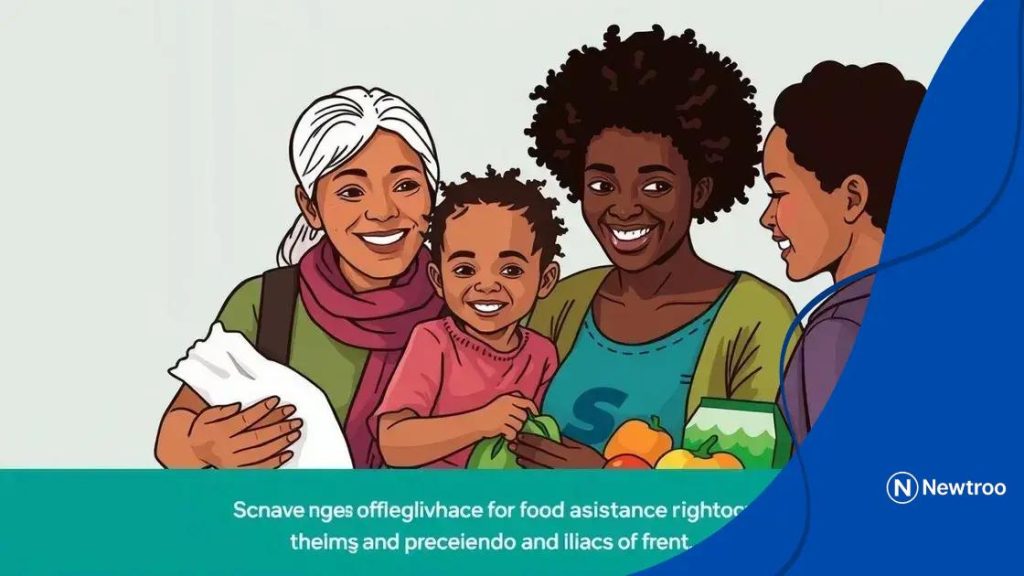SNAP usage under federal scrutiny: What’s at stake?

Anúncios
SNAP usage under federal scrutiny raises concerns about potential changes in eligibility and oversight, which could significantly impact low-income families’ access to essential food assistance programs.
SNAP usage under federal scrutiny has become a hot topic, sparking debates about food assistance and its implications for millions. Curious about how this affects you? Let’s dive in.
Anúncios
Understanding SNAP and its purpose
Understanding SNAP, the Supplemental Nutrition Assistance Program, is vital for many families across the United States. This program is designed to provide food assistance to those in need, helping to alleviate hunger and improve nutrition.
SNAP works by providing eligible households with funds to purchase food. Here’s how it helps:
The Basics of SNAP
SNAP is not only about food purchases. It also aims to support families in a variety of ways, ensuring they have access to nutritious meals. This can lead to better overall health and economic stability.
Anúncios
Key Benefits of SNAP
- Assists low-income households in affording food.
- Helps improve overall nutrition and health.
- Boosts local economies by increasing food sales.
- Encourages healthier eating choices.
Implementing SNAP can lead to significant positive outcomes in communities. By helping families secure their basic food needs, SNAP plays a crucial role in supporting a healthier society. Additionally, SNAP offers resources for educating participants on healthy eating.
The impact of SNAP goes beyond just food assistance. It also supports local farmers and businesses, as every dollar spent on SNAP benefits contributes to the economy. Moreover, successful programs have demonstrated that SNAP effectively reduces poverty and improves the quality of life for many.
Recent federal scrutiny and concerns
Recent federal scrutiny on SNAP usage has raised significant concerns among policymakers and advocates. As federal agencies review the program, many question how effectively it serves the vulnerable populations that rely on it.
One primary concern is the potential for fraud. This issue has led to heated debates about program integrity and oversight. Ensuring that benefits go to those who truly need them is crucial for maintaining the program’s credibility.
Issues Under Review
Several key areas have come under scrutiny:
- Fraud detection methods and their effectiveness.
- The accuracy in reporting household income and expenses.
- The criteria for eligibility and how they impact access.
- Changes in the economy affecting food security and program need.
As reviews continue, stakeholders are concerned that increased scrutiny could lead to stricter regulations. While the goal is to eliminate fraud, this could inadvertently hinder access for eligible families. It’s important to balance integrity with accessibility.
Some advocates argue that the focus on fraud may overshadow discussions regarding the adequacy of benefits. Many households struggle to meet basic needs, and it’s essential to consider how SNAP benefits can adequately support them. Addressing concerns about fraud should not compromise the assistance families receive.
Impacts on low-income families

The impacts of SNAP on low-income families are profound and multifaceted. For many households, this program serves as a critical lifeline, helping them afford basic nutrition and maintain their health.
Families that receive SNAP benefits can allocate their resources more effectively, ensuring they have enough food while managing other essential costs. Regular access to nutritious food plays a vital role in overall well-being and development, especially for children.
Benefits of SNAP for Families
Here are some key benefits that low-income families gain from SNAP:
- Increased food security, reducing the risk of hunger.
- Improved health outcomes by allowing access to healthier food options.
- Enhanced educational performance among children due to better nutrition.
- Economic support that allows families to invest in other needs.
Moreover, the positive effects of SNAP extend beyond individual households. As families participate in the program, local economies also benefit. Increased spending in grocery stores helps support local businesses and farmers. This creates a cycle of economic improvement in communities.
However, some families face challenges accessing these benefits, such as complicated application processes or stigma surrounding the program. It’s essential to address these barriers to ensure that all eligible families can benefit from SNAP. Access to food is a fundamental right, and overcoming these challenges is key to supporting vulnerable populations.
Possible changes to SNAP regulations
Possible changes to SNAP regulations are currently being discussed, sparking a variety of opinions and concerns. As the government reviews how the program operates, many are anxious about how these adjustments could impact families relying on this assistance.
Some of the proposed changes include stricter eligibility criteria and enhanced verification processes. These measures aim to ensure that benefits are directed to those most in need, reducing potential fraud. However, such changes could inadvertently create barriers for eligible families.
Key Areas of Potential Change
Here are some significant areas where changes may occur:
- Reevaluation of income thresholds for eligibility.
- Increased scrutiny on asset limits.
- Changes to the list of approved food items.
- Enhanced reporting requirements for beneficiaries.
These adjustments could have various effects. For instance, lowering the income eligibility limits might disqualify some families already facing economic hardship. On the other hand, increasing oversight can help ensure that public funds are used effectively, instilling more confidence in the program.
It’s crucial to recognize that any changes to SNAP should balance accountability with accessibility. Families already facing challenges should not be further burdened by complex requirements or restrictions. Ensuring that SNAP remains a resource for those in need is a priority that policymakers must consider.
Future of food security initiatives
The future of food security initiatives is brighter yet complex, especially in the wake of increased SNAP scrutiny. As policymakers explore ways to boost food assistance programs, there is a growing emphasis on innovation and community involvement.
One potential direction involves integrating technology into food distribution systems. Digital platforms can enhance accessibility for low-income families, allowing them to order groceries online or find local food resources more easily.
Emerging Strategies in Food Security
Several strategies are gaining traction in the fight for food security:
- Partnerships between local farms and food banks to reduce food waste.
- Community gardens that empower neighborhoods to grow their own food.
- Policy changes to increase funding for food assistance programs.
- Nutrition education initiatives that teach families about healthy eating.
Moreover, there is a focus on preventative measures to address the root causes of hunger. By investing in education and job training, communities can help families become self-sufficient, reducing their reliance on programs like SNAP over time.
As these initiatives evolve, collaboration among government agencies, non-profits, and businesses will be key. Recognizing that food security is essential for a stable and thriving community is crucial. It requires a concerted effort from all sectors to innovate and adapt to the changing landscape.
FAQ – Frequently Asked Questions about SNAP and Food Security
What is SNAP and how does it help families?
SNAP, or the Supplemental Nutrition Assistance Program, provides nutritional assistance to eligible low-income families, helping them afford food.
What are the recent concerns regarding SNAP regulations?
Recent concerns include potential fraud, changes in eligibility requirements, and the need for effective oversight to ensure assistance reaches those in need.
How could changes to SNAP regulations impact low-income families?
Changes could create barriers for some families, reducing access to benefits at a time when they are most needed, making it crucial to balance scrutiny with support.
What future initiatives are being considered for food security?
Future initiatives may include technology integration for better access to food, community partnerships, and programs focused on sustainable solutions to eliminate hunger.